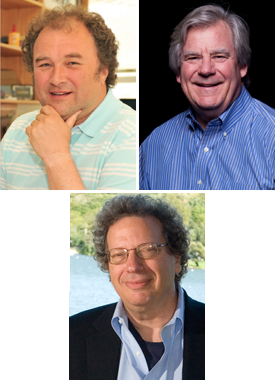October is National Breast Cancer Awareness Month
Cold Spring Harbor, NY — Scientists at Cold Spring Harbor Laboratory (CSHL), a National Cancer Institute-designated Cancer Center, are conducting cutting-edge research aimed at developing new diagnostics and therapies for breast cancer.
Targeting the breast cancer microenvironment

Traditionally, breast cancer has been fought with therapy that aims to kill the tumor cells. To grow and spread to other organs, breast tumor cells require supportive signals from normal cells in their local microenvironment. Strategies that interrupt such supporting signals are an important new front in the fight against breast cancer. At CSHL, Mikala Egeblad, Ph.D. uses advanced imaging technologies to study how the normal cells in the breast cancer microenvironment support growth, therapy resistance, and metastatic spread of breast tumor cells. Dr. Egeblad’s group used these imaging methods to show that white blood cells help tumor cells survive chemotherapy. They also found that tumors responded much better to chemotherapy when these white blood cells were prevented from entering breast tumors. With her colleague Scott Powers, Ph.D., at CSHL, Dr. Egeblad has identified signals—from a cell type called fibroblasts—that help breast cancer cells grow faster. Dr. Egeblad’s laboratory is currently investigating whether these signals could be new therapeutic targets to improve outcomes of breast cancer patients.
RNAi-based analysis of breast cancers
RNA-interference (RNAi), a powerful genetic tool pioneered in large part by CSHL scientist Gregory Hannon, Ph.D. allows scientists to systematically turn off the expression of genes to determine their function. Dr. Hannon’s group is analyzing human breast cancer lines with RNAi-based tools to identify new therapeutic targets that can be tested in clinical trials by collaborators at UCLA. The Hannon laboratory is also using RNAi to investigate the characteristics of cancer stem cells in breast tumors. This research will potentially identify the specific cells responsible for progression and metastasis in breast cancer. Recent work by his group has focused on gaining an understanding of how pregnancy decreases a woman’s risk of developing breast cancer. Findings from these studies may lead to new preventative strategies for breast cancer.
Splicing-based breast cancer therapies
Adrian Krainer, Ph.D. is a leading researcher in the area of RNA splicing—an intermediate step in the process by which genetic instructions encoded in DNA are translated into proteins. Cancer cells often generate RNA messages that are edited, or spliced, abnormally, leading to the production of abnormal proteins that can increase cell division, movement, and resistance to programmed cell death. Research by Dr. Krainer’s group has shown that over-expression of SRSF1, a protein that controls splicing, results in the development of breast cancer in animal models and causes normal human breast cells to acquire characteristics of cancer cells. In addition to SRSF1, other splicing factors are over-expressed in human breast tumors, suggesting that they may also play a role in breast cancer. Current research by the Krainer lab on splicing factors and splicing misregulation in breast cancer is aimed at developing splicing-based therapies for breast cancer.
Identifying therapeutic targets that can impede breast cancer metastasis

Metastasis, or spread of a primary cancer to other sites in the body, is a leading cause of breast cancer-associated mortality. Research in the laboratory of David L. Spector, Ph.D. is focused on identifying and characterizing therapeutic targets that can be manipulated to interfere with breast cancer metastasis. In addition to genes that encode proteins, the human genome encodes a huge repertoire of RNA molecules that do not make proteins; collectively they are called non-coding RNAs. Recently, the Spector group used a breast cancer mouse model to identify a specific non-coding RNA whose loss significantly impacts the ability of breast cancer cells to metastasize to the lungs. They showed that treatment with a small molecule that can seek out and degrade this specific RNA effectively reduced tumor growth and significantly reduced or eliminated metastasis. The lab is now conducting research to characterize this RNA’s mechanism of action and is performing genome-wide screens to identify additional therapeutic targets that can be manipulated to prevent breast cancer metastasis.
Novel approaches to breast cancer treatment
Phosphatases are proteins involved in signal transduction—the process by which a stimulus from outside a cell initiates a cascade of signaling events inside the cell that can modify its growth, differentiation, survival, movement and metabolism. DNA mutations that affect the function of phosphatases cause a number of human diseases, including cancer. At CSHL, Nicholas Tonks, Ph.D. conducts research on a family of phosphatases called protein tyrosine phosphatases (PTPs), a largely untapped source for development of new therapies. Research has shown that the protein tyrosine phosphatase PTP1B, which Dr. Tonks discovered, plays a role in HER2-positive breast cancer. Although the targeted therapy Herceptin® is effective in HER2-positive breast cancer, patients often develop resistance to the drug. Recent research in Dr. Tonks’ laboratory has produced evidence that an inhibitor to PTP1B prevents metastasis in mouse models of HER2-positive breast cancer. Dr. Tonks is working with clinicians at North Shore-LIJ Medical Center to test this drug in an upcoming clinical trial in women with HER2-positive metastatic breast cancer.
DNA diagnostic tools for breast cancer
CSHL scientists Michael Wigler, Ph.D. and James Hicks, Ph.D. are analyzing the genomes of women with breast cancer in research aimed at eliminating “trial-and-error” approaches to therapy. Their work is leading to diagnostic tests capable of distinguishing cancers likely to spread, which should receive aggressive treatment, from those that are benign and can be left untreated. Drs. Hicks and Wigler are using powerful technologies that they developed to analyze genomic and epigenetic changes in thousands of breast cancers and have identified three distinct categories of breast cancer DNA profiles associated with different outcomes for patients. Their research has provided important information about which patients are most likely to benefit from treatment with specific drugs, such as taxol and Herceptin®. Drs. Wigler and Hicks have also developed a sensitive technology called single nucleus sequencing (SNS) that can identify genetic changes in very small samples, which can be used to follow genetic changes as tumors progress and to identify specific changes that can predict which tumors are likely to metastasize. The group is continuing to make technological improvements to make it affordable and feasible for SNS to be used as a monitoring tool for early detection of cancer cells in the blood, and to direct therapy based on the genetic makeup of those circulating cancer cells.
Written by: Paula Smith, Director - Foundation & Government Relations | publicaffairs@cshl.edu | 516-367-8455